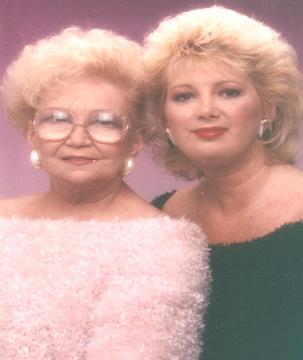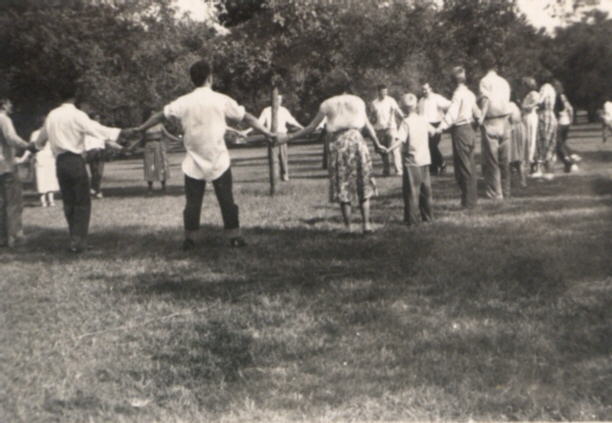
LaVona Lawson James Lucky
1928 - 1997
The Sweet Family
Natural Born Healers

LaVona Lawson James Lucky
1928 - 1997
The Sweet Family
Natural Born Healers
La Vona Irene Lawson, (Lil) my mother, was born October 5, 1928, in Oklahoma. Her parents, Virgil Lawson and Hazel Brisbin, born 31 Oct. 1909, granddaughter of Wm. Albert Brisbin and Edith Caroline Sweet, great granddaughter of Elizabeth Sweet and Wm. E. Bookout, all from the Ozark Country of Missouri. Wm. Albert Brisbin's parent's, were Samuel Brisbin born 1822, Coberg, Montreal, Canada, and Amanda Melvina Barney, born 9 April 1826.
My mother's line from her maternal grandfather's side, started with Jacob Barney. Jacob was born 1601 in England. Jacob died 28 Apr 1673 at Salem, Essex, Massachusetts, family story is that around the "Burning Time" in the United States, the family moved northward, some to Canada.
Mom was a crafter, an artist and quilter, an art
she learned from the women in her family, passed down from generation to
generation. She could look at something and draw, make or build
it by hand.
"I See The Wise Woman"
As a Libra, you could never fool her, she always saw both sides of the story! She married my father, Paul Jesse James, May Day 1950. They lived in a tight family community in Wichita, Kansas, both worked for Beech Aircraft, until she remarried Jack E. Lucky in 1957, we then moved to Illinois, just across the river from St. Louis. (As a child in school, we could watch the St. Louis arch being built!)
 Our family has ritualized many of life's passages. Baby showers, every
new baby is given a quilt of squares made and signed by all of the female
members of the family. (I still have mine) The women of the family gather
at the hospital/or birthing room during the birth.
Our family has ritualized many of life's passages. Baby showers, every
new baby is given a quilt of squares made and signed by all of the female
members of the family. (I still have mine) The women of the family gather
at the hospital/or birthing room during the birth.
Birthdays, the family gathers together to celebrate and blow out the candles on the birthday cake (candle magick). Marriages, the mother and or grandmother makes a quilt for the marriage bed. I was lucky to have had both, as have each of my girls (from their grandmother and great grandmother)
The family still gathers at the hospital or home during any illness or death and the elders of the church have always been called to do a laying on hands and blessings, from pregnancies, to illness to death. As my family has been LDS since the church began, I see many corresponding church rituals.
Early in our family history, it was the men that had the distinct title of "bonesetter"! My mother's line on her mother's side was one of the Sweet lines that went south to the mountains of the Ozarks.
My mother's great grandmother and great aunt were called "Granny Women" and were apparently rather "famous" in their area of the Ozarks. In many areas, Granny Women were the closest thing you would see to a witch.
Mom's great aunt was Delila Jane "Dilly", a Granny-woman, born 7 Feb. 1857, Taney County, Missouri - Although Baptist, she was a "yarb" (herb) doctor and midwife locally for a number of years. On the 1880 Stone County, Missouri census she is noted as a servant of Zack Jennings & family. In a letter from her granddaughter, Virginia Bookout-Hartzell, , she wrote, "Dilly cried when Birdie, as a child, gave her a valentine because she had never learned to read and write. She signed her name with an 'x'. Her father drove a team of oxen up from 'Caintuck' (Kentucky) when he was 12 years old as his father was dead. Her mother died when Dilly was 15 years old. Her father fought in the Civil War. (She never said which side he was on)." Folk medicine, especially knowledge of healing herbs, was a largely feminine art though male "yarb" doctors were not unknown in the Ozarks.Excerpt from American Folk Magick by Silver Ravenwolf: "The growth of Pow Wow, with the extended families of those days, the woman were the natural midwives and doctors for their kith and kin. The demise of Pow Wow began when woman lost control of the Pow Wow system. As PW evolved in Southern PA, the rest of the world was active in the occult. PW practitioners let go of the religious aspect of the craft and the charlatans had taken over, throwing hexes on anyone for a price.
As the PW women were shunned from the craft, witches went to the North and took on the name of Bone Setters, those that went south were called Faith healers, grannies and water witches. Women, still the natural midwives and doctors for their kin and neighbors but had to go underground during that era."
Granny-women might perform a number of rituals
which doctors found silly and irrational. Some were designed to give the
mother psychological, if not physical, relief from her pain. She might give
the woman her husband's hat to hold during the ordeal, thus bringing him
symbolically into the delivery room. If the labor were particularly severe,
she would place an axe or knife under the bed to "cut" the pain. Sometimes,
weather permitting, she would throw open every door and window in the house,
in a symbolic representation of opening the birth canal. http://goddessschool.com/projects/grannywomen.html
Granny women, it is clear, rendered a kind of care that physicians could
not reproduce. It involved far more than simply dispensing a drug: It meant
giving psychological support, material comfort, and empathy -- something
that only another woman who had undergone the same experience could provide.
My mother, passed away December 2, 1997 of a horrible disease called Scleroderma and PulmonaryHypertension. I will never forget her, she is with me always.
My Beautiful
Mother
Our heritage is one
I thank you for life
I thank you for love
I thank you for your wisdom.
Honoring our family tree and
the moon above
I thank you
Blessed Be!
Copyright Yvonne Jame-Henderson

The Sweet family is known as the Bonesetter Sweets. Stephen, and James, sons of Sylvester, were in the Revolutionary War. (Taken from Recollections of "Ye Olden Times" by Thomas R. Hazard, 1879.)
John SWEET son of Robert SWEET/Johanna RAINHAM emigrated to USA 1630 from Wales with wife Mary (PERIAM) and ch John, James, and Renewed. They emigrated to Salem, Mass in 1630. He was progenitor of the "celebrated natural bone setters" Source: The SWEET SAGA, by Belle Smiley and Iola Young (1960)
1657 James SWEET s/o James and Mary GREENE born. Died 1724. He was the father of Job SWEET who became known as the "Great Bonesetter" and was the most famous of all the Bonesetter SWEETs. He surpassed the achievements of any of his forebears. Job SWEET began to practice this natural gift while yet in his teens, winning celebrity wherever he applied his art.
Besides the bone-setting gift, the Sweet family
have another faculty; that of compounding liniments or washes from the roots
and barks that are to be found in almost every neighborhood and which are
highly efficacious in reducing
inflammation and swellings and in preventing mortification.
There is a tradition in the Narragansett family of Sweets that their ancestors including James the first immigrant to Rhode Island, had long been gifted by nature with the faculty of setting dislocated and broken bones. James reared a large family and among them a son Benoni, and to this Benoni a son, James, was born June 18, 1688. This James and his father Benoni both possessed the "natural gift" of setting dislocated bones; to what extent it was exercised is not definitely known.
Job, the son of the second James, the first great "bonesetter," was born December 1, 1728, and died on a farm about a mile from Narragansett Pier in Point Judith, Rhode Island.
Job obtained an eminent and widespread reputation as a bone-setter. He was styled Dr. Sweet. During the Revolution he was called to Newport to set dislocated bones of the French officials, an operation their army surgeons were unable to do. After the war Colonel Burr invited him to New York to restore the hipbone of his daughter which had previously baffled the skill of the city surgeons. He had a son, Benoni, who also practiced and although totally unlearned in surgery Dr. Job Sweet seldom failed in his bone-restoring operations. Benoni, a son of Job, born October 17, 1762, removed to Lebanon, Connecticut, where until his death he was celebrated as a natural bone-setter. Jonathan, another son of Job, born September 6, 1765, settled at Sugar Loaf Hill near Wakefield, Rhode Island, and he restored many broken and dislocated bones.
He removed to Boston where he died 1827. On the
removal of Job to Boston, William his brother, born October
25, 1802, resided at Sugar Loaf Hill and commenced in the bone-setting
line but gave way to his brother John, son of Gideon who had relinquished
farming to devote all his time to the business of bonesetting. After a time
John moved to New Bedford and then William again resumed bone-setting in
South Kingstown and has probably been as successful in his calling as anyone
of the name. Job, his eldest son, is now (1879) a skillful bone-setter practicing
in New Bedford, and vicinity. George, a younger son, lives with his brother
Job, and sets bones when his brother is away. William N. Sweet, another son
of William, lives with Job but practices principally in Boston, Fall River
and their vicinities. He, too, is said to be very successful in his calling.
Jonathan, another son, also practiced in Providence for ten years until
his death in 1867. Edward, youngest son of William, lives in the homestead
at Sugar Loaf, and occasionally sets bones when his father is absent.
Jonathan Sweet, son of the last named Job and
grandson of William, practices bone-setting in Newark, New Jersey. James,
also a son of Job; and Samuel, son of Gideon, now both live in South Kingston,
inherit the gift and occasionally in cases of necessity replace dislocated
and broken bones. In consequence of existence and enforcement of laws in
New York, making it a misdemeanor for natural bone-setters, so many have
had to forego their calling in the state of New York.
![]()
Copyright 2000
Yvonne James-Henderson